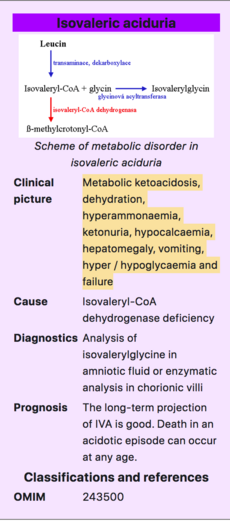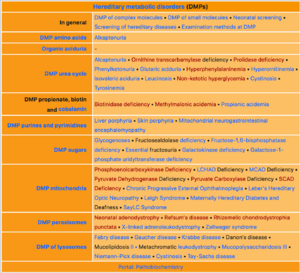Isovaleric aciduria
Isovaleric aciduria (IVA) is an organic aciduria . It is caused by the body's inability to process the amino acid leucine due to isovaleryl-CoA dehydrogenase deficiency. The enzyme isovaleryl-CoA dehydrogenase is the third step in the metabolism of branched-chain organic acids from leucine. Deficiency of this enzyme increases the level of toxic metabolites.
Flooding of the organism by toxic metabolites occurs at each load with an increased amount of leucine. This can happen, for example, during normal weight loss in the neonatal period , during the breakdown of the baby's body proteins during fever and starvation, during common infections, after operations and in similar stressful situations.
IVA is an AR inherited disease ( gene 15q14-q15-IVD, OMIM # 243500 ). The incidence of IVA is 1: 230,000 (worldwide). Since October 1, 2009, it has been a part of nationwide neonatal screening in the Czech Republic. Elevated C5 carnitine (isovalerylcarnitine) indicates evidence of IVA. If IVA is suspected, plasma acylcarnitine analysis (confirmed to increase in C5) and urinary organic acid analysis (demonstrated by isovalerylglycine) is performed immediately to confirm the diagnosis. In some cases, IVA will not show further tests because the first screening test is unable to distinguish it from a harmless laboratory abnormality - 2-methylbutyrylglycinuria.
Clinical manifestations[edit | edit source]
In the case of the acute form, the onset of symptoms is most often between the 3rd and 7th day after birth. In the case of the chronic form, it is a little later. Newborns experience metabolic ketoacidosis, " sweaty feet " or "sweaty socks" (due to accumulation of isovaleric acid), dehydration, hyperammonaemia, ketonuria, hypocalcaemia, hepatomegaly, vomiting, hyper / hypoglycaemia and failure to thrive. In addition, there are suppressed bone marrow functions with neutropenia, thrombocytopenia and pancytopenia. These can then lead to a heart attack and / or cerebral hemorrhage. On the other hand, there are also milder forms without manifestations in the neonatal period. The chronic intermittent form is presented later in childhood, by episodes of metabolic acidosiswhich are usually associated with associated disease or increased protein intake .
No dysmorphic changes are seen during the physical examination.
Therapy[edit | edit source]
One of the best measures is to prevent the patient's catabolic states and starvation. Furthermore, a low-protein diet with leucine restriction. This method of diet consists in reducing protein, where the permitted amount of special low-protein foods is consumed. All these foods are provided by each patient for their own nutrition and are not reimbursed by health insurance companies. Such glycine supplementation allows the formation of isovalerylglycine, which is less toxic and can be used to degrade more toxic isovaleryl-CoA. It is also possible to supplement your diet with carnitine . With any common viral or bacterial infection, it is necessary to reduce protein intake even more in the short term at an early stage of the disease and to provide more energy in the form of glucose with insulin by intravenous infusion . During acute attacks, it is necessary to use elimination methods that filter out toxic metabolites from the body.
Prognosis[edit | edit source]
The long-term prognosis of IVA with appropriate treatment is good. Death in an acidotic episode can occur at any age.
Progression of the disease[edit | edit source]
The course of the disease with treatment: The prognosis of the achieved intelligence of the patient depends on the timeliness of diagnosis and initiation of treatment and subsequently on the influence of long-term cooperation of the patient. When properly treated, most patients develop normally.
Course of the disease without treatment: About 50% of patients with acute neonatal disease die at the first attack. Survivors have neurological damage, although some patients recover completely neurologically. Chronic patients may have neurological impairment, but usually have normal growth and development.
Prenatal diagnosis[edit | edit source]
In other children who have the same father and mother as the affected child, the risk of this disease is 25%. Prenatal diagnosis is possible by analysis of isovalerylglycine in amniotic fluid or by enzymatic analysis in chorionic villi.
Links[edit | edit source]
[edit | edit source]
Reference[edit | edit source]
- DOC. MUDR. VOTAVA, Felix, CSc., Tomas, PhD. DOC. RNDR. ADAM and Jiří, DrSc. PROF. MUDR. ZEMAN, et al. Neonatal screening [online]. © 2009. Last revision 2009, [cited. December 17, 2009]. < http://www.novorozeneckyscreening.cz/nemoci >.


